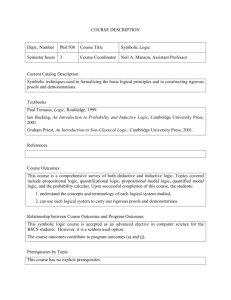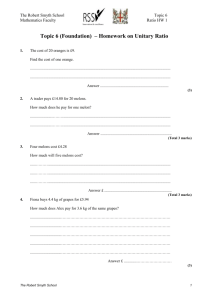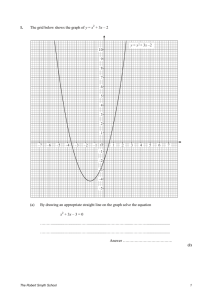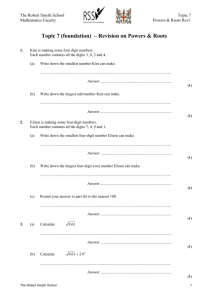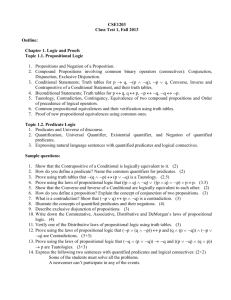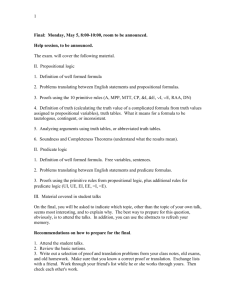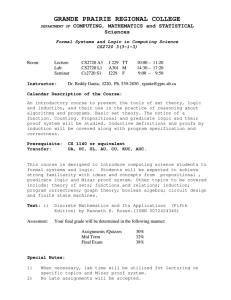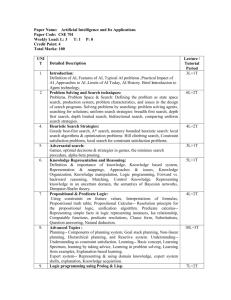Game Playing
advertisement
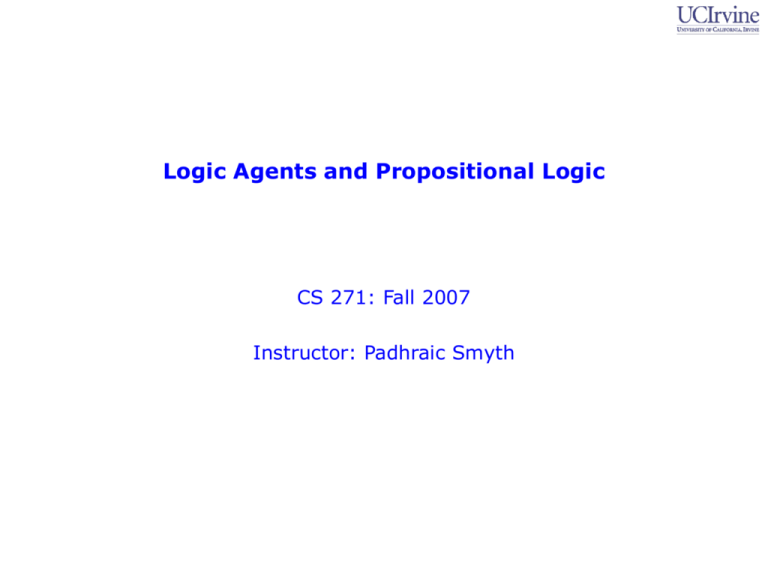
Logic Agents and Propositional Logic
CS 271: Fall 2007
Instructor: Padhraic Smyth
Organizational Issues
• Grading
–
–
–
–
Homeworks: 35%
Midterm: 30%
Final: 35%
Extra credit option
• Midterm
– In class, closed book/notes
– Vote on date
• Homework 3
– Now on Web page, due Thursday
CS 271, Fall 2007: Professor Padhraic Smyth
Topic 7: Propositional Logic 2
Knowledge-Based Agents
• KB = knowledge base
– A set of sentences or facts
– e.g., a set of statements in a logic language
• Inference
– Deriving new sentences from old
– e.g., using a set of logical statements to infer new ones
• A simple model for reasoning
– Agent is told or perceives new evidence
• E.g., A is true
– Agent then infers new facts to add to the KB
• E.g., KB = { A -> (B OR C) }, then given A and not C we can
infer that B is true
• B is now added to the KB even though it was not explicitly
asserted, i.e., the agent inferred B
CS 271, Fall 2007: Professor Padhraic Smyth
Topic 7: Propositional Logic 3
Wumpus World
• Wumpus can be shot, only 1 arrow
– Shoot: arrow goes forward
• Bottomless pits and pot of gold
• Agent can move forward, turn left or
turn right
• Sensors:
–
–
–
–
–
Stench next to wumpus
Breeze next to pit
Glitter in square with gold
Bump when agent moves into a wall
Scream from wumpus when killed
CS 271, Fall 2007: Professor Padhraic Smyth
Topic 7: Propositional Logic 4
Reasoning in the Wumpus World
• Agent has initial ignorance about the configuration
– Agent knows his/her initial location
– Agent knows the rules of the environment
• Goal is to explore environment, make inferences (reasoning) to
try to find the gold.
• Random instantiations of this problem used to test agent
reasoning and decision algorithms
(applications? “intelligent agents” in computer games)
CS 271, Fall 2007: Professor Padhraic Smyth
Topic 7: Propositional Logic 5
Exploring the Wumpus World
[1,1] The KB initially contains the rules of the environment.
The first percept is [none, none,none,none,none],
move to safe cell e.g. 2,1
CS 271, Fall 2007: Professor Padhraic Smyth
Topic 7: Propositional Logic 6
Exploring the Wumpus World
[2,1] = breeze
indicates that there is a pit in [2,2] or [3,1],
return to [1,1] to try next safe cell
CS 271, Fall 2007: Professor Padhraic Smyth
Topic 7: Propositional Logic 7
Exploring the Wumpus World
[1,2] Stench in cell which means that wumpus is in [1,3] or [2,2]
YET … not in [1,1]
YET … not in [2,2] or stench would have been detected in [2,1]
(this is relatively sophisticated reasoning!)
CS 271, Fall 2007: Professor Padhraic Smyth
Topic 7: Propositional Logic 8
Exploring the Wumpus World
[1,2] Stench in cell which means that wumpus is in [1,3] or [2,2]
YET … not in [1,1]
YET … not in [2,2] or stench would have been detected in [2,1]
(this is relatively sophisticated reasoning!)
THUS
THUS
THUS
move
… wumpus is in [1,3]
[2,2] is safe because of lack of breeze in [1,2]
pit in [1,3] (again a clever inference)
to next safe cell [2,2]
CS 271, Fall 2007: Professor Padhraic Smyth
Topic 7: Propositional Logic 9
Exploring the Wumpus World
[2,2] move to [2,3]
[2,3] detect glitter , smell, breeze
THUS pick up gold
THUS pit in [3,3] or [2,4]
CS 271, Fall 2007: Professor Padhraic Smyth
Topic 7: Propositional Logic 10
What our example has shown us
• Can represent general knowledge about an environment by a
set of rules and facts
• Can gather evidence and then infer new facts by combining
evidence with the rules
• The conclusions are guaranteed to be correct if
– The evidence is correct
– The rules are correct
– The inference procedure is correct
-> logical reasoning
• The inference may be quite complex
– E.g., evidence at different times, combined with different rules, etc
CS 271, Fall 2007: Professor Padhraic Smyth
Topic 7: Propositional Logic 11
What is a Logic?
• A formal language
– KB = set of sentences
• Syntax
– what sentences are legal (well-formed)
– E.g., arithmetic
• X+2 >= y is a wf sentence, +x2y is not a wf sentence
• Semantics
– loose meaning: the interpretation of each sentence
– More precisely:
• Defines the truth of each sentence wrt to each possible world
– e.g,
• X+2 = y is true in a world where x=7 and y =9
• X+2 = y is false in a world where x=7 and y =1
– Note: standard logic – each sentence is T of F wrt eachworld
• Fuzzy logic – allows for degrees of truth.
CS 271, Fall 2007: Professor Padhraic Smyth
Topic 7: Propositional Logic 12
Models and possible worlds
• Logicians typically think in terms of models, which are formally
structured worlds with respect to which truth can be
evaluated.
• m is a model of a sentence if is true in m
• M() is the set of all models of
• Possible worlds ~ models
– Possible worlds: potentially real environments
– Models: mathematical abstractions that establish the truth or
falsity of every sentence
• Example:
– x + y = 4, where x = #men, y = #women
– Possible models = all possible assignments of integers to x and y
CS 271, Fall 2007: Professor Padhraic Smyth
Topic 7: Propositional Logic 13
Entailment
• One sentence follows logically from another
|= b
entails sentence b if and only if b is true in all worlds where
is true.
e.g., x+y=4 |= 4=x+y
• Entailment is a relationship between sentences that is based
on semantics.
CS 271, Fall 2007: Professor Padhraic Smyth
Topic 7: Propositional Logic 14
Entailment in the wumpus world
•
Consider possible models for KB assuming only pits and a reduced
Wumpus world
•
Situation after detecting nothing in [1,1], moving right, detecting
breeze in [2,1]
CS 271, Fall 2007: Professor Padhraic Smyth
Topic 7: Propositional Logic 15
Wumpus models
All possible models in this reduced Wumpus world.
CS 271, Fall 2007: Professor Padhraic Smyth
Topic 7: Propositional Logic 16
Wumpus models
• KB = all possible wumpus-worlds consistent with the
observations and the “physics” of the Wumpus world.
CS 271, Fall 2007: Professor Padhraic Smyth
Topic 7: Propositional Logic 17
Inferring conclusions
• Consider 2 possible conclusions given a KB
– α1 = "[1,2] is safe"
– α2 = "[2,2] is safe“
• One possible inference procedure
– Start with KB
– Model-checking
• Check if KB ╞ by checking if in all possible models where KB
is true that is also true
• Comments:
– Model-checking enumerates all possible worlds
• Only works on finite domains, will suffer from exponential
growth of possible models
CS 271, Fall 2007: Professor Padhraic Smyth
Topic 7: Propositional Logic 18
Wumpus models
α1 = "[1,2] is safe", KB ╞ α1, proved by model checking
CS 271, Fall 2007: Professor Padhraic Smyth
Topic 7: Propositional Logic 19
Wumpus models
α2 = "[2,2] is safe", KB ╞ α2
There are some models entailed by KB where 2 is false
CS 271, Fall 2007: Professor Padhraic Smyth
Topic 7: Propositional Logic 20
Logical inference
• The notion of entailment can be used for logic inference.
– Model checking (see wumpus example): enumerate all possible
models and check whether is true.
• If an algorithm only derives entailed sentences it is called
sound or truth preserving.
– Otherwise it just makes things up.
i is sound if whenever KB |-i it is also true that KB|=
– E.g., model-checking is sound
• Completeness : the algorithm can derive any sentence that is
entailed.
i is complete if whenever KB |= it is also true that KB|-i
CS 271, Fall 2007: Professor Padhraic Smyth
Topic 7: Propositional Logic 21
Schematic perspective
If KB is true in the real world, then any sentence derived
from KB by a sound inference procedure is also true in the
real world.
CS 271, Fall 2007: Professor Padhraic Smyth
Topic 7: Propositional Logic 22
Propositional logic: Syntax
• Propositional logic is the simplest logic – illustrates basic ideas
• Atomic sentences = single proposition symbols
– E.g., P, Q, R
– Special cases: True = always true, False = always false
• Complex sentences:
– If S is a sentence, S is a sentence (negation)
– If S1 and S2 are sentences, S1 S2 is a sentence (conjunction)
– If S1 and S2 are sentences, S1 S2 is a sentence (disjunction)
– If S1 and S2 are sentences, S1 S2 is a sentence (implication)
– If S1 and S2 are sentences, S1 S2 is a sentence (biconditional)
CS 271, Fall 2007: Professor Padhraic Smyth
Topic 7: Propositional Logic 23
Propositional logic: Semantics
Each model/world specifies true or false for each proposition symbol
E.g. P1,2
P2,2
P3,1
false
true
false
With these symbols, 8 possible models, can be enumerated automatically.
Rules for evaluating truth with respect to a model m:
S
is true iff
S is false
S1 S2
is true iff
S1 is true and
S2 is true
S1 S2
is true iff
S1is true or
S2 is true
S1 S2 is true iff
S1 is false or
S2 is true
i.e.,
is false iff
S1 is true and
S2 is false
S1 S2 is true iff
S1S2 is true andS2S1 is true
Simple recursive process evaluates an arbitrary sentence, e.g.,
P1,2 (P2,2 P3,1) = true (true false) = true true = true
CS 271, Fall 2007: Professor Padhraic Smyth
Topic 7: Propositional Logic 24
Truth tables for connectives
CS 271, Fall 2007: Professor Padhraic Smyth
Topic 7: Propositional Logic 25
Truth tables for connectives
Implication is always true
when the premise is false
Why? P=>Q means “if P is true then I am claiming that Q is true,
otherwise no claim”
Only way for this to be false is if P is true and Q is false
CS 271, Fall 2007: Professor Padhraic Smyth
Topic 7: Propositional Logic 26
Wumpus world sentences
Let Pi,j be true if there is a pit in [i, j].
Let Bi,j be true if there is a breeze in [i, j].
start:
•
P1,1
B1,1
B2,1
"Pits cause breezes in adjacent squares"
B1,1
B2,1
(P1,2 P2,1)
(P1,1 P2,2 P3,1)
•
KB can be expressed as the conjunction of all of these
sentences
•
Note that these sentences are rather long-winded!
– E.g., breese “rule” must be stated explicitly for each square
– First-order logic will allow us to define more general relations
(later)
CS 271, Fall 2007: Professor Padhraic Smyth
Topic 7: Propositional Logic 27
Truth tables for the Wumpus KB
CS 271, Fall 2007: Professor Padhraic Smyth
Topic 7: Propositional Logic 28
Inference by enumeration
• We want to see if is entailed by KB
• Enumeration of all models is sound and complete.
• But…for n symbols, time complexity is O(2n)...
• We need a more efficient way to do inference
– But worst-case complexity will remain exponential for propositional
logic
CS 271, Fall 2007: Professor Padhraic Smyth
Topic 7: Propositional Logic 29
Logical equivalence
•
•
To manipulate logical sentences we need some rewrite rules.
Two sentences are logically equivalent iff they are true in same models: α ≡ ß
iff α╞ β and β╞ α
CS 271, Fall 2007: Professor Padhraic Smyth
Topic 7: Propositional Logic 30
Validity and satisfiability
A sentence is valid if it is true in all models,
e.g., True,
A A,
(tautologies)
A A,
(A (A B)) B
Validity is connected to inference via the Deduction Theorem:
KB ╞ α if and only if (KB α) is valid
A sentence is satisfiable if it is true in some model
e.g., A B, C
(determining satisfiability of sentences is NP-complete)
A sentence is unsatisfiable if it is false in all models
e.g., AA
Satisfiability is connected to inference via the following:
KB ╞ α if and only if (KB α) is unsatisfiable
(there is no model for which KB=true and is false)
(aka proof by contradiction: assume to be false and this leads to
contraditions in KB)
CS 271, Fall 2007: Professor Padhraic Smyth
Topic 7: Propositional Logic 31
Proof methods
•
Proof methods divide into (roughly) two kinds:
Application of inference rules:
Legitimate (sound) generation of new sentences from old.
• Resolution
• Forward & Backward chaining
Model checking
Searching through truth assignments.
• Improved backtracking: Davis--Putnam-Logemann-Loveland (DPLL)
• Heuristic search in model space: Walksat.
CS 271, Fall 2007: Professor Padhraic Smyth
Topic 7: Propositional Logic 32
Normal Form
We want to prove: KB |
equivalent to : KB unsatifiable
We first rewrite KB into conjunctive normal form (CNF).
A “conjunction of disjunctions”
literals
(A B) (B C D)
Clause
Clause
• Any KB can be converted into CNF
• k-CNF: exactly k literals per clause
CS 271, Fall 2007: Professor Padhraic Smyth
Topic 7: Propositional Logic 33
Example: Conversion to CNF
B1,1 (P1,2 P2,1)
1.
Eliminate , replacing α β with (α β)(β α).
2.
Eliminate , replacing α β with α β.
3.
Move inwards using de Morgan's rules and double-negation:
4.
Apply distributive law ( over ) and flatten:
(B1,1 (P1,2 P2,1)) ((P1,2 P2,1) B1,1)
(B1,1 P1,2 P2,1) ((P1,2 P2,1) B1,1)
(B1,1 P1,2 P2,1) ((P1,2 P2,1) B1,1)
(B1,1 P1,2 P2,1) (P1,2 B1,1) (P2,1 B1,1)
CS 271, Fall 2007: Professor Padhraic Smyth
Topic 7: Propositional Logic 34
Resolution Inference Rule for CNF
(A B C )
(A)
“If A or B or C is true, but not A, then B or C
must be true.”
(B C )
(A B C )
( A D E )
(B C D E )
“If A is false then B or C must be true,
or if A is true then D or E must be true,
hence since A is either true or false, B or
C or D or E must be true.”
(A B )
(A B )
Simplification
(B B ) B
CS 271, Fall 2007: Professor Padhraic Smyth
Topic 7: Propositional Logic 35
Resolution Algorithm
•
The resolution algorithm tries to prove: KB | equivalent to
KB unsatisfiable
•
•
Generate all new sentences from KB and the query.
One of two things can happen:
1. We find P P which is unsatisfiable,
i.e. we can entail the query.
2. We find no contradiction: there is a model that satisfies the
Sentence (non-trivial) and hence we cannot entail the query.
KB
CS 271, Fall 2007: Professor Padhraic Smyth
Topic 7: Propositional Logic 36
Resolution example
• KB = (B1,1 (P1,2 P2,1)) B1,1
• α = P1,2
KB
True
False in
all worlds
CS 271, Fall 2007: Professor Padhraic Smyth
Topic 7: Propositional Logic 37
Horn Clauses
• Resolution in general can be exponential in space and time.
• If we can reduce all clauses to “Horn clauses” resolution is linear in space and time
A clause with at most 1 positive literal.
e.g. A B C
• Every Horn clause can be rewritten as an implication with
a conjunction of positive literals in the premises and a single
positive literal as a conclusion.
e.g. B C A
• 1 positive literal: definite clause
• 0 positive literals: Fact or integrity constraint:
e.g. (A B ) (A B False )
CS 271, Fall 2007: Professor Padhraic Smyth
Topic 7: Propositional Logic 38
Forward-chaining pseudocode
CS 271, Fall 2007: Professor Padhraic Smyth
Topic 7: Propositional Logic 39
Forward chaining: graph representation
• Idea: fire any rule whose premises are satisfied in the KB,
– add its conclusion to the KB, until query is found
AND gate
OR gate
•
Forward chaining is sound and complete for Horn KB
CS 271, Fall 2007: Professor Padhraic Smyth
Topic 7: Propositional Logic 40
Forward chaining example
“OR” Gate
“AND” gate
CS 271, Fall 2007: Professor Padhraic Smyth
Topic 7: Propositional Logic 41
Forward chaining example
CS 271, Fall 2007: Professor Padhraic Smyth
Topic 7: Propositional Logic 42
Forward chaining example
CS 271, Fall 2007: Professor Padhraic Smyth
Topic 7: Propositional Logic 43
Forward chaining example
CS 271, Fall 2007: Professor Padhraic Smyth
Topic 7: Propositional Logic 44
Forward chaining example
CS 271, Fall 2007: Professor Padhraic Smyth
Topic 7: Propositional Logic 45
Forward chaining example
CS 271, Fall 2007: Professor Padhraic Smyth
Topic 7: Propositional Logic 46
Forward chaining example
CS 271, Fall 2007: Professor Padhraic Smyth
Topic 7: Propositional Logic 47
Backward chaining
Idea: work backwards from the query q
•
•
•
check if q is known already, or
prove by BC all premises of some rule concluding q
Hence BC maintains a stack of sub-goals that need to
be proved to get to q.
Avoid loops: check if new sub-goal is already on the goal stack
Avoid repeated work: check if new sub-goal
1. has already been proved true, or
2. has already failed
Like FC, is linear and is also sound and complete (for Horn KB)
CS 271, Fall 2007: Professor Padhraic Smyth
Topic 7: Propositional Logic 48
Backward chaining example
CS 271, Fall 2007: Professor Padhraic Smyth
Topic 7: Propositional Logic 49
Backward chaining example
CS 271, Fall 2007: Professor Padhraic Smyth
Topic 7: Propositional Logic 50
Backward chaining example
CS 271, Fall 2007: Professor Padhraic Smyth
Topic 7: Propositional Logic 51
Backward chaining example
we need P to prove
L and L to prove P.
CS 271, Fall 2007: Professor Padhraic Smyth
Topic 7: Propositional Logic 52
Backward chaining example
CS 271, Fall 2007: Professor Padhraic Smyth
Topic 7: Propositional Logic 53
Backward chaining example
CS 271, Fall 2007: Professor Padhraic Smyth
Topic 7: Propositional Logic 54
Backward chaining example
CS 271, Fall 2007: Professor Padhraic Smyth
Topic 7: Propositional Logic 55
Backward chaining example
CS 271, Fall 2007: Professor Padhraic Smyth
Topic 7: Propositional Logic 56
Backward chaining example
CS 271, Fall 2007: Professor Padhraic Smyth
Topic 7: Propositional Logic 57
Backward chaining example
CS 271, Fall 2007: Professor Padhraic Smyth
Topic 7: Propositional Logic 58
Forward vs. backward chaining
• FC is data-driven, automatic, unconscious processing,
– e.g., object recognition, routine decisions
• May do lots of work that is irrelevant to the goal
• BC is goal-driven, appropriate for problem-solving,
– e.g., Where are my keys? How do I get into a PhD program?
• Complexity of BC can be much less than linear in size of KB
CS 271, Fall 2007: Professor Padhraic Smyth
Topic 7: Propositional Logic 59
Model Checking
Two families of efficient algorithms:
• Complete backtracking search algorithms: DPLL algorithm
• Incomplete local search algorithms
– WalkSAT algorithm
CS 271, Fall 2007: Professor Padhraic Smyth
Topic 7: Propositional Logic 60
Satisfiability problems
• Consider a CNF sentence, e.g.,
(D B C) (B A C) (C B E) (E D B)
(B E C)
Satisfiability: Is there a model consistent with this sentence?
CS 271, Fall 2007: Professor Padhraic Smyth
Topic 7: Propositional Logic 62
The WalkSAT algorithm
• Incomplete, local search algorithm
– Begin with a random assignment of values to symbols
– Each iteration: pick an unsatisfied clause
• Flip the symbol that maximizes number of satisfied clauses, OR
• Flip a symbol in the clause randomly
• Trades-off greediness and randomness
• Many variations of this idea
• If it returns failure (after some number of tries) we cannot tell
whether the sentence is unsatisfiable or whether we have not
searched long enough
– If max-flips = infinity, and sentence is unsatisfiable, algorithm
never terminates!
• Typically most useful when we expect a solution to exist
CS 271, Fall 2007: Professor Padhraic Smyth
Topic 7: Propositional Logic 63
Pseudocode for WalkSAT
CS 271, Fall 2007: Professor Padhraic Smyth
Topic 7: Propositional Logic 64
Hard satisfiability problems
• Consider random 3-CNF sentences. e.g.,
(D B C) (B A C) (C B E) (E D B)
(B E C)
m = number of clauses (5)
n = number of symbols (5)
– Underconstrained problems:
• Relatively few clauses constraining the variables
• Tend to be easy
• 16 of 32 possible assignments above are solutions
– (so 2 random guesses will work on average)
CS 271, Fall 2007: Professor Padhraic Smyth
Topic 7: Propositional Logic 65
Hard satisfiability problems
•
What makes a problem hard?
– Increase the number of clauses while keeping the number of
symbols fixed
– Problem is more constrained, fewer solutions
– Investigate experimentally….
CS 271, Fall 2007: Professor Padhraic Smyth
Topic 7: Propositional Logic 66
P(satisfiable) for random 3-CNF sentences, n = 50
CS 271, Fall 2007: Professor Padhraic Smyth
Topic 7: Propositional Logic 67
Run-time for DPLL and WalkSAT
•
Median runtime for 100 satisfiable random 3-CNF sentences, n = 50
CS 271, Fall 2007: Professor Padhraic Smyth
Topic 7: Propositional Logic 68
Inference-based agents in the wumpus world
A wumpus-world agent using propositional logic:
P1,1 (no pit in square [1,1])
W1,1 (no Wumpus in square [1,1])
Bx,y (Px,y+1 Px,y-1 Px+1,y Px-1,y) (Breeze next to Pit)
Sx,y (Wx,y+1 Wx,y-1 Wx+1,y Wx-1,y) (stench next to Wumpus)
W1,1 W1,2 … W4,4 (at least 1 Wumpus)
W1,1 W1,2 (at most 1 Wumpus)
W1,1 W8,9
…
64 distinct proposition symbols, 155 sentences
CS 271, Fall 2007: Professor Padhraic Smyth
Topic 7: Propositional Logic 69
Limited expressiveness of propositional logic
•
KB contains "physics" sentences for every single square
•
For every time t and every location [x,y],
Lx,y FacingRightt Forwardt Lx+1,y
•
Rapid proliferation of clauses.
First order logic is designed to deal with this through the
introduction of variables.
CS 271, Fall 2007: Professor Padhraic Smyth
Topic 7: Propositional Logic 70
Summary
• Logical agents apply inference to a knowledge base to
derive new information and make decisions
• Basic concepts of logic:
–
–
–
–
–
–
syntax: formal structure of sentences
semantics: truth of sentences wrt models
entailment: necessary truth of one sentence given another
inference: deriving sentences from other sentences
soundness: derivations produce only entailed sentences
completeness: derivations can produce all entailed
sentences
• Resolution is complete for propositional logic
• Forward, backward chaining are linear-time, complete
for Horn clauses
• Propositional logic lacks expressive power
CS 271, Fall 2007: Professor Padhraic Smyth
Topic 7: Propositional Logic 71
